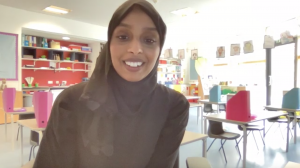by Aidan Said | September 29, 2021
Our new Teacher Feature series highlights how special education teachers have adapted their classroom during the pandemic and how they have each uniquely implemented FrenalyticsEDU into their classroom. This edition features Kafia, a primary school teacher at Prior Weston Primary in London, England, who will begin using FrenalyticsEDU this fall.
Kafia Yousof is a primary school teacher at Prior Weston Primary School in London, England. Prior Weston is a mainstream school, which promotes inclusion-style instruction with students receiving special education services in a general education classroom. In Kafia’s hybrid classroom, about one-fifth of her students have special needs, while the rest are considered neurotypical. This fresh and innovative type of classroom is a new concept in the UK, and Kafia is one of the first teachers who will be teaching primarily in this hybrid environment. These circumstances add an air of importance to Kafia’s classroom, as the success of students in classrooms like hers will dictate how the UK proceeds going forwards with special education.
Since COVID-19 struck right as she was finishing training, Kafia’s early career as a special education teacher is particularly memorable, as she’s spent more time teaching during a pandemic than under normal classroom conditions. Kafia reflected on the unique perspective she developed on the role of technology in education at large, as well as special education:
I have more experience teaching during a pandemic than I do outside of a pandemic, which of course no one expected, and I would say that my first few months were challenging, of course – I had no idea what was to come.”
Kafia is a part of a new wave of instruction that advocates for mainstream classrooms, where special needs students and neurotypical students learn together, in order to enhance their learning and push their development. She believes that it is better for students to try learning in an environment like this whenever possible, before going to an dedicated special needs school:
There has been a push in special education for quite a while now for children with [special] needs to be in mainstream school, at least to try it out and see if they can, before deciding with the parent and the educators that work closely with the child that elsewhere might be better for them.”
Kafia also believes there is a lot of value to be found in assigning unique objectives for each student, based on their learning goals and situation. To achieve this, she formulates “success criteria” that define what she hopes her students gain out of each lesson, where she then breaks them down into three categories: what she wants all the students to be able to do, what she wants most of the students to be able to do, and finally, what she wants some of the students to be able to do. Kafia and her partner teacher define “success criteria” for all of their students, not just those with special needs:
Anything you do for students with special educational needs will also be beneficial for all children in the classroom, because you don’t know what misconceptions a child might have or what makes them more reluctant to ask questions.”
In the UK, teachers are responsible for completing Education Health and Care Plans (EHCPs) on a regular basis. Kafia explained how there are similarities between this document for special needs students and the USA’s equivalent – the Individualized Education Program (IEP):
- Both programs are meant to enhance the learning of special needs students, and given the individual plans, students’ unique needs can be met and addressed through these.
- IEPs detail all the necessary factors for a successful special education program, made custom for each student to ensure their success.
- IEPs make note of every factor that could affect the success of a student, from their motor skills, social skills, and to more traditional educational categories like math and literacy.
- EHCPs are usually more like legal documents, outlining the special educational needs of a child, in order to ensure they are given the support they need by the local authorities and school systems.
- These support systems are vital for teachers like Kafia, as they can understand how to best educate and care for students’ needs, as well as for school administrators.
- These support systems are vital for teachers like Kafia, as they can understand how to best educate and care for students’ needs, as well as for school administrators.

The EHCP structure contains the Child’s/Parent’s Goals (Section A), Special Educational Needs (SEN), Health Needs, and Social Care Needs (Sections, B, C, D), Target Outcomes (Section E), and Required SEN Provisioning, Health Provisioning, and Social Care Provisioning (Sections F, G, H1 & H2). Credit: Barner Local Office
Similar to IEPs, there are certain assessment tests administered to complete EHCPs. Kafia echoed feedback from Jen Gentile at Escondido High School and Michaela Duranti at Quad Prep on how she can use FrenalyticsEDU data in order to more accurately gauge a student’s development and enhance their EHCP to make it as accurate as possible. When it comes to reading, Kafia shared how FrenalyticsEDU can help with assessing a student’s reading in her class, as data within FrenalyticsEDU not only helps depict each student’s skill level, but it also helps make the labor-intensive task of developing individualized plans easier, especially for teachers who have larger classrooms with many students to account for:
With reading, I would say particularly is where Frenalytics would come in really perfectly, because you can’t listen to a (mute) child read to assess where they are, and the data that comes from [Frenalytics] would just give you a better reflection when you then go on to have your pupil progress meetings to show the progress the child has made. You would have the data to be able to prove it, rather than just going off of where you feel they are.”
Kafia’s focus on forging toward individual learning objectives did not falter during the COVID pandemic. While still being relatively new to teaching, Kafia’s tech-savvy nature helped her continue the quality of her teaching, even with the new virtual environment. Kafia discussed how the new online learning style can be seen as a positive, as it prompts students to develop their technological skills and independence, both of which are vital life skills. She also wants to make sure she is doing her part in order to make this digital learning experience as interactive as possible, keeping all her students engaged and present during her lessons and assignments.
The adjustment to a virtual learning environment also prompted Kafia to pivot to using some new technology in order to achieve these learning goals while still teaching remotely. One such tool is a platform called ClassDojo, an educational technology tool that helps keep teachers, students, and parents all connected and keyed into a student’s individual progress.
Kafia is also now looking forward to beginning using FrenalyticsEDU this coming fall. She intends to implement Frenalytics in a multitude of ways and with all her students, not just those with special needs. In Kafia’s mind, using FrenalyticsEDU for reading comprehension will serve as a far superior alternative to the traditional methods of worksheets and books themselves. With FrenalyticsEDU, Kafia can assess each student’s comprehension of the materials gone over in class and can make actionable plans based on each student’s Session Dashboard statistics. By creating customized assignments for her students on the platform, Kafia believes her students will be more engaged and interested as well:
I think in times like this we really could use Frenalytics. If we were going to respond to a text that we’d read whole class … I think it just makes it a lot more engaging than having six different worksheets printed out for each lesson every single day, it will make it a lot more interactive for the children.”
By integrating FrenalyticsEDU into her curriculum and success criteria for all of her students this fall, Kafia says she expects to increase the interactivity of online learning, save herself some time in grading, and give herself access to more data to analyze that is offered by FrenalyticsEDU – a win-win for her students, their parents, and of course, Kafia and her partner teacher.
Frenalytics is loved by students in special ed schools from kindergarten all the way through high school. We are the first comprehensive and interactive software platform to streamline life skills learning within special education, including enrolling students, managing transitions, and reporting outcomes. Our team at Frenalytics works extensively with educators to craft a one-of-a-kind software platform that helps students live more independent lives while saving time and money for parents and schools.
Want to see how Frenalytics helps special needs students live more independent lives?
Click here to learn more, or give us a call at (516) 399-7170.
Aidan Said is a rising sophomore at Boston College studying Finance and Business Analytics. As a member of the Frenalytics team, Aidan has enjoyed diving into the world of special education, while also learning about Frenalytics’ business development and marketing initiatives. Other than work and school, Aidan is a cadet in Air Force ROTC and is passionate about fitness and working out. Contact Aidan: aidan@frenalytics.com


